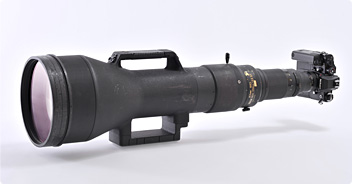
Zoom-Nikkor 1200-1700mm f/5.6-8P IF-ED
Lens construction: 18 elements in 13 groups
Picture angle (diagonal): 2°-1°30'
Number of diaphragm blades: 9
Closest focusing distance: 10 m
Weight: 16,000 g
Size (maximum diameter × maximum length): 237 mm × 888 mm
The Zoom-Nikkor 1200-1700mm f/5.6-8P IF-ED lens for use on single-lens reflex cameras (hereafter, the 1200-1700mm) was first used in 1990 at the Koshien Stadium, the baseball ground at which the spring high school baseball tournament is staged.*1
The following description of this lens, which at the time boasted the longest focal length of any zoom lens for 35mm-format cameras*2, includes comments by the two men who were respectively responsible for its optical design and its mechanical design.
- *1High school baseball: Team tournaments in which every prefecture in Japan is represented by a local high school. These tournaments are held in spring and summer at the Hanshin Koshien Stadium in Nishinomiya, Hyogo Prefecture. Hugely popular in Japan, the tournaments are widely covered by the newspapers and on television.
- *2Based on Nikon research as of September 1994.
Super telephoto zoom lens for special requirements
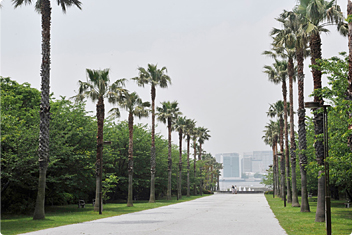
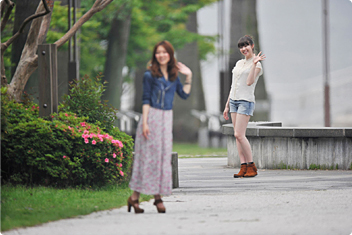
 Comparison photos taken from 130 meters away. The top image was taken with a 50mm lens, the middle image with a 1200mm focal length (the distance between the two subjects is 18 meters—similar to the distance between pitcher and home plate). The bottom image was taken at 1700mm.
Comparison photos taken from 130 meters away. The top image was taken with a 50mm lens, the middle image with a 1200mm focal length (the distance between the two subjects is 18 meters—similar to the distance between pitcher and home plate). The bottom image was taken at 1700mm.
At Koshien Stadium the photographers' seats are situated next to the center-field back screen so as to enable news photographers to shoot the home plate, which is over 130 meters away. From this position it requires a focal length of 1200mm to capture the pitcher, the catcher, and the batter in frame, and a focal length of 1700mm to shoot a full-frame vertical photograph of the batter. In short, the 1200-1700mm was developed for shooting pictures from the photographers' seats at Koshien Stadium.
In 1980s, a rival company was making a 1200mm f/5.6 super telephoto lens. The newspapers were beginning to switch over to cameras made by this company in order to use the lens in their coverage of baseball at Koshien Stadium.
In May 1989, Nikon rushed to begin development of its own super telephoto lens for Koshien Stadium. The company resolved to complete the prototype by March 1990, in response to the fervent wishes of the newspapers.
"In order to complete the prototype by March, we had to complete the blueprints by the preceding July. Time was short. Moreover, we just didn't know where to start," says the mechanical designer of the lens.
"Seeing that we were developing a lens from scratch, it would be pointless if we did not surpass our competitor. The competitor's lens had a built-in teleconverter, which served as the mechanism for switching the focal length between 1200mm and 1700mm. We decided not to use a switching mechanism, and instead selected a zoom mechanism that enabled the photographer to freely adjust the focal length in the 1200mm to 1700mm range. Although the zoom method is more complex (both optically and mechanically), we knew that it would make framing adjustment easier and produce better photographs," adds the lens's optical designer.
The adoption of a two-section lens barrel
A comparison of the vertical/horizontal rotating mechanisms
In general (above), the entire lens barrel is rotated, but with the 1200-1700mm (below), only the rear section is rotated.
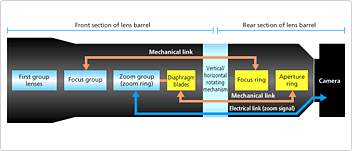
Mechanical and electrical links between the two sections of the lens barrel span the vertical/horizontal rotating mechanism. The rotation of the focus ring is converted into front-to-back motion, which is transmitted to the focus group.
Telephoto lenses with a tripod collar commonly feature a structure in which the entire lens barrel is rotated in order to change the composition from vertical to horizontal (this is referred to hereafter as the vertical/horizontal rotating mechanism). However, it would require considerable strength to rotate an entire lens barrel that weighed as much as that of the 1200-1700mm. To enable smooth vertical/horizontal rotating, the lens barrel of the 1200-1700mm is divided into front and rear sections, and only the rear section is rotated.
With the 1200-1700mm, whose front section of lens barrel is fixed, rotating the position of the camera between vertical and horizontal rotates the focus ring. Focus does not change, however, since care is taken in the design of the vertical/horizontal rotating mechanism to ensure that movement in the mechanism does not affect the rotation of the focus ring.
Since all the element lenses are located in the front section of the lens barrel, the focus group, which is used for focusing the image, is located more than 60 cm in front of the camera. However, rather than being adjacent to the focus group, the focus ring is in the rear section of the lens barrel. In other words, the focus group and the focus ring are connected to each other via a mechanical link that is more than 60 cm in length and which bridges the vertical/horizontal rotating mechanism.
"Focusing is a crucial operation in photography. For this reason, the focus ring was positioned in the rear section of the lens barrel, so as to facilitate its operation by the photographer. Although its mechanical structure was complex, it was highly regarded for its ease of use." recounts the mechanical designer.
Aiming for the last word in optical performance
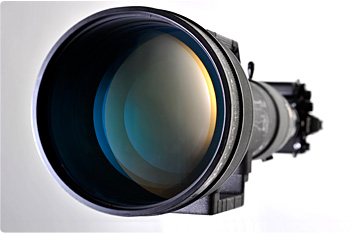 The lenses in the first lens group of the 1200-1700mm have apertures as large as 200 mm.
The lenses in the first lens group of the 1200-1700mm have apertures as large as 200 mm.
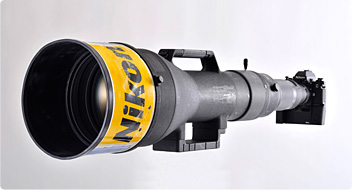 At first glance the lens appears enormous. However, its maximum length is 888 mm, which is only approximately half of its maximum focal length. In order to reduce the size of the unit as much as possible, a high-power lens was included in each lens group. The technicians developing the lens reportedly measured the width of the photographers' seats in person in order to determine its maximum possible length. Since the lens above was being lent to the press, the Nikon sticker appeared on the lens hood.
At first glance the lens appears enormous. However, its maximum length is 888 mm, which is only approximately half of its maximum focal length. In order to reduce the size of the unit as much as possible, a high-power lens was included in each lens group. The technicians developing the lens reportedly measured the width of the photographers' seats in person in order to determine its maximum possible length. Since the lens above was being lent to the press, the Nikon sticker appeared on the lens hood.
Each successive lens group along the length of the super telephoto lens further enlarges the image created by the first lens group, and the final image is created on the surface of the film. If the first lens group produces a low-quality image, that poor image will be enlarged and the resulting picture will inevitably be of low quality. The largest lens in the first lens group in the 1200-1700mm has a diameter aperture of 200 mm. In order to obtain high-quality images, the surface of this large-diameter lens had to be polished to a hitherto unprecedented degree of precision. This represented a considerable challenge for Nikon's lens polishers at the time. However, when it was explained to them that the goal was to outdo Nikon's competitor, they naturally buckled down to the task.
At the assembly stage too, an unprecedented level of precision was required with regard to the camera lenses. Accordingly, at the suggestion of the person in charge of assembly, adjustments were carried out using equipment used to adjust IC steppers and scanners. The technology of IC steppers and scanners—dubbed the "most precise machines in history"—was thus applied to the 1200-1700mm. Given the hectic production schedule for IC steppers and scanners, however, the development team was only permitted to use the adjustment equipment for a single day. With no time to spare to redo any of the work, the operation was completed in a highly tense atmosphere.
The prototype was completed in February 1990. All processes (including the optical design, mechanical design, lens processing, working of the metallic components, assembly, and adjustment) were carried out without any major hitch and trial production was completed in short order. The prototype was then subjected to rigorous testing (including photographic tests), which represented the final stage in the completion of the prototype of the super telephoto lens—the highest-precision Nikon lens at that time.
Now for Koshien!
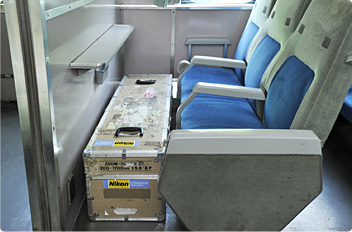 Photographers dubbed the lens "the tuna" and the case "the coffin," on account of their size.
Photographers dubbed the lens "the tuna" and the case "the coffin," on account of their size.
Image courtesy of Ome Railway Park
On 25 March 1990, the day before the start of the spring Koshien tournament, the prototype was transported to Koshien Stadium. A row of three seats was secured on the Shinkansen bound for Shin Osaka Station for the enormous trunk case that would be used to transport the 1200-1700mm. It took the two men who developed the lens plus a Nikon professional service technician to carefully transport the lens to its destination in such a manner as to avoid any vibration that might reduce the precision of the lens. It was for this reason that the Shinkansen was chosen to transport the lens, which was treated with the same care afforded a work of art because of the few existing prototype lenses.
Newspaper photographers were reportedly speechless at the sheer size of the lens. However, they were full of praise for the sharp pictures that it took and for its ease of use.
"With a relative aperture of f/5.6, the lens was not that fast. This meant that we had to consider how best to obtain sharp images—even when the photographer was shooting at full aperture. The 1200-1700mm proved convenient in that during the day time the photographer could shoot at full aperture using a fast shutter speed—even when it was dark." recalled the optical designer.
On March 27, 1990, images shot with the 1200-1700mm appeared in newspapers alongside reports of the opening day at Koshien.
Subsequently, the 1200-1700mm performed sterling service at stadiums all over Japan as well as at Koshien Stadium. It was also used by news organizations overseas. Although initially targeted at news organizations, from 1994 onwards the lens was also made available on the general market and built to order for members of the public.
The legacy of the 1200-1700mm
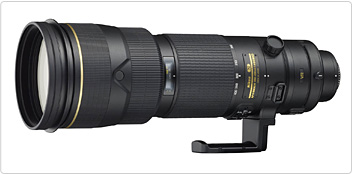 AF-S NIKKOR 200-400mm f/4G ED VR II
AF-S NIKKOR 200-400mm f/4G ED VR II
The experience and technology acquired in the development of the 1200-1700mm were applied to the full in the development of this lens.
The 1200-1700mm restored the reputation of the Nikon brand in terms of news photography. With the rise to prominence of digital SLR cameras, however, the lens has essentially fallen into disuse. This is because with digital SLR cameras the images can be easily cropped and image quality is high, even with a high ISO setting.
Meanwhile, the experience that the engineers of the 1200-1700mm gained in developing the lens has subsequently been put to good use in the development of contemporary super telephoto lenses. For example, the development of the 1200-1700mm led to the development of the first high-precision adjustment equipment specifically for large-diameter lenses used in camera lenses. This equipment is still used in the production of super telephoto lenses today.
"It still seems amazing that we were able to achieve such a high level of performance in such a short period of time. The teamwork of the Nikon engineers produced a truly miraculous lens," agreed the optical designer and mechanical designer.
In addition to the fever-pitch battles at Koshien, engineers were also engaged in a behind-the-scenes struggle of another kind. The battle between Nikon and its competitors still continues to this day, with the press sections at baseball grounds also deserving of the spectators' attention.

